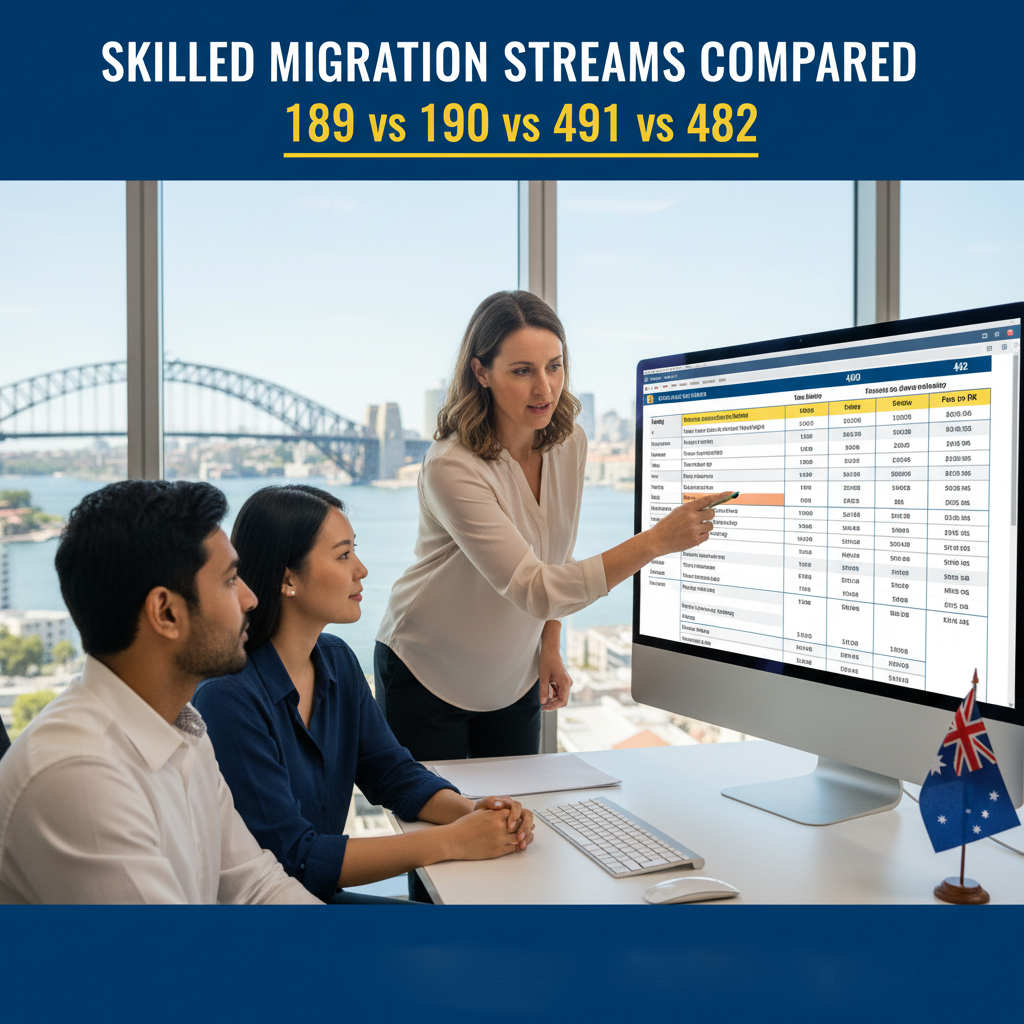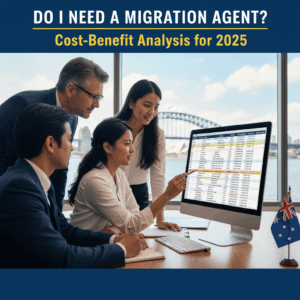Compare Australia’s skilled migration streams—subclass 189, 190, 491, and 482 visas—to find the best pathway for permanent residency or temporary work.
Introduction
Choosing the right skilled migration stream is crucial for a successful Australian visa application. With multiple options like subclass 189, 190, 491, and 482, understanding their differences, eligibility, and benefits can save time and improve your chances. This article compares these popular skilled visas to help you make an informed decision.
Overview of Skilled Migration Streams
Australia offers several skilled migration visas tailored to different needs. The subclass 189 visa is a permanent, points-tested visa that allows you to live and work anywhere in Australia without sponsorship. The subclass 190 visa also grants permanent residency but requires nomination by a state or territory, often with a commitment to live and work there for at least two years. The subclass 491 visa is a provisional visa for skilled workers willing to live and work in regional areas, offering a pathway to permanent residency. Lastly, the subclass 482 visa is an employer-sponsored temporary visa for skilled workers filling positions that cannot be sourced locally.
Each visa stream targets different applicant profiles and offers distinct advantages depending on your circumstances.
Subclass 189 Visa: Skilled Independent Visa
The subclass 189 visa is highly sought after because it offers permanent residency without the need for employer or state sponsorship. It is a points-based visa requiring a minimum of 65 points, which are calculated based on age, education, work experience, English proficiency, and other factors.
Key Features:
- No sponsorship required: Apply independently.
- Live and work anywhere in Australia.
- Permanent residency: Full access to Medicare, social security, and the ability to sponsor relatives.
- Occupation eligibility: Must be on the Medium and Long-term Strategic Skills List (MLTSSL).
- English proficiency: Competent English required (IELTS 6.0 or equivalent).
Because the subclass 189 visa offers freedom to live anywhere and is not tied to a sponsor, it is ideal for highly qualified applicants with competitive points.
Subclass 190 Visa: Skilled Nominated Visa
The subclass 190 visa also grants permanent residency but requires nomination from an Australian state or territory government. This nomination often comes with obligations to live and work in the nominating state for at least two years.
Key Features:
- State or territory nomination required.
- Permanent residency with similar benefits as subclass 189.
- Additional 5 points awarded for nomination, helping meet the points threshold.
- Occupation must be on the Combined List of Eligible Skilled Occupations.
- Commitment to live and work in the nominating state for 2 years.
This visa suits applicants willing to settle in a specific state or territory and can benefit from the extra points nomination provides.
Subclass 491 Visa: Skilled Work Regional (Provisional) Visa
The subclass 491 visa targets skilled workers who want to live and work in regional Australia. It is a provisional visa valid for up to five years and provides a pathway to permanent residency through the subclass 191 visa after meeting residency and income requirements.
Key Features:
- State, territory, or eligible family member nomination required.
- Must live and work in designated regional areas.
- Provisional visa valid for 5 years.
- Pathway to permanent residency after 3 years of regional residence and meeting income thresholds.
- Occupation must be on the Regional Occupation List.
This visa encourages skilled migration to regional areas, supporting local economies and addressing regional skill shortages.
Subclass 482 Visa: Temporary Skill Shortage Visa
The subclass 482 visa allows Australian employers to sponsor overseas skilled workers to fill positions they cannot source locally. It is a temporary visa with short-term and medium-term streams, depending on the occupation.
Key Features:
- Employer sponsorship required.
- Temporary visa valid from 2 to 4 years, depending on stream.
- Medium-term stream occupations may lead to permanent residency via subclass 186 visa.
- Short-term stream generally does not lead directly to permanent residency.
- English language and skills assessment requirements apply.
This visa is ideal for workers with a job offer from an Australian employer and who want to gain Australian work experience.
Comparing Eligibility and Benefits
| Feature | Subclass 189 | Subclass 190 | Subclass 491 | Subclass 482 |
|---|---|---|---|---|
|
Visa Type |
Permanent | Permanent | Provisional (pathway to PR) | Temporary |
|
Sponsorship Required |
No | Yes (State/Territory) | Yes (State/Territory/Family) |
Yes (Employer) |
|
Occupation List |
Medium & Long-term Skills | Combined Skilled Occupations | Regional Occupation List | Short and Medium-term Lists |
|
Points Test |
Yes | Yes | Yes | No |
|
English Requirement |
Competent English | Competent English | Competent English | Varies by stream |
| Work Location | Anywhere in Australia | Nominating State/Territory | Regional Australia |
With sponsoring employer |
| Pathway to Permanent Residency | Immediate | Immediate | After 3 years regional stay |
Possible via subclass 186 |
| Family Inclusion | Yes | Yes | Yes |
Yes |
Practical Tips for Choosing the Right Visa
- If you want flexibility and no sponsorship: Subclass 189 is best.
- If you are willing to live in a specific state and want extra points: Consider subclass 190.
- If you want to live in regional Australia and are open to provisional status: Subclass 491 is suitable.
- If you have a job offer from an Australian employer: Subclass 482 may be your pathway.
Assess your occupation, points score, and personal circumstances before applying. Consulting a registered migration agent can help tailor your strategy.
Conclusion
Understanding the differences between subclass 189, 190, 491, and 482 visas is essential to choosing the right skilled migration stream. Each visa has unique eligibility criteria, benefits, and obligations. Whether you seek permanent residency without sponsorship, state-nominated benefits, regional opportunities, or employer sponsorship, Australia offers pathways to suit your needs. Evaluate your options carefully and plan your migration journey with confidence.


